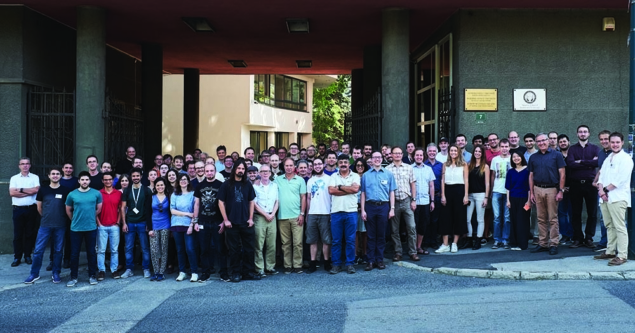
The 11th ROOT Users’ Workshop was held on 10–13 September in Sarajevo, Bosnia and Herzegovina, at the Academy of Science and Arts: an exceptional setting that also provided an opportunity to involve Bosnia and Herzegovina in CERN’s activities.
The SoFTware Development for Experiments group in the experimental physics department at CERN drives the development of ROOT, a modular software toolkit for processing, analysing and visualising scientific data. ROOT is also a means to read and write data: LHC experiments alone produced about 1 exabyte of data stored in the ROOT file format.
Thousands of high-energy physicists use ROOT daily to produce scientific results. For the ROOT team, this is a big responsibility, especially considering the challenges Run 3 at the LHC and the High Luminosity LHC (HL-LHC) pose to all of us. Luckily, we can rely on a lively user community, whose contribution is so useful that, periodically, a ROOT users’ workshop is organised. The event’s objective is to gather together the ROOT community of users and developers to collect criticism, praise and suggestions: a unique occasion to shape the future of the ROOT project.
More than 100 people attended this year’s workshop, a 30% increase from 2015, making the event a success. What’s more, the diversity of the attendees – students, analysis physicists, software experts and framework developers – brought different levels of expertise to the event. The workshop featured 69 contributions as well as engaging discussions. Software companies participated, with three invited contributions: Peter Müßig from SAP presented OpenUI5, the core of the SAP javascript framework that will be used for ROOT’s graphical user interface; Chandler Carruth from Google discussed ways to make large-scale software projects written in C++, the language for number-crunching code in high-energy and nuclear physics (HENP), simpler, faster and safer; and Sylvain Corlay from Quantstack showed novel ways to tackle numerical analysis with multidimensional array expressions. These speakers said they enjoyed the workshop and plan to come to CERN to extend the collaboration.
ROOT’s renovation was the workshop’s main theme. To be at the bleeding edge of software technology, ROOT – which has been the cornerstone of virtually all HENP software stacks for two decades – is undergoing an intense upgrade of its key components. This effort represents an exciting time for physicists and software developers. In the event, ROOT users expressed their appreciation of the effort to make it easier to use and faster on modern computer architectures, with the sole objective of reducing the time interval between data delivery and the presentation of plots.
In particular, the spotlight was on the modernisation of the I/O subsystem, crucial for the future LHC physics programme; ROOT’s parallelisation, a prerequisite to face Run 3 and HL-LHC analyses; as well as on new graphics, multivariate tools and an interface to the Python language, which are all elements of prime importance for scientists’ everyday work.
The participants’ feedback was enthusiastic, the atmosphere was positive, and the criticism received was constructive and fruitful for the ROOT team. We thank the participating physicists and computer scientists: we appreciated your engagement and are looking forward to organising the next ROOT workshop.







